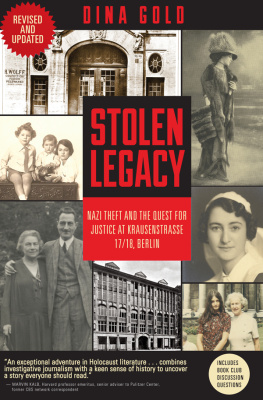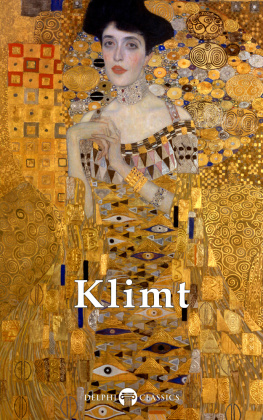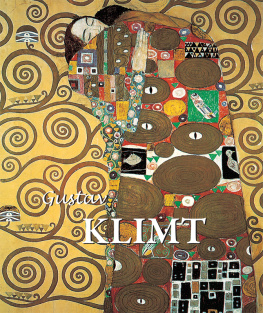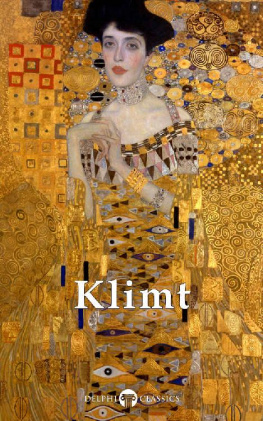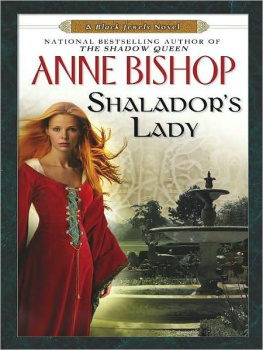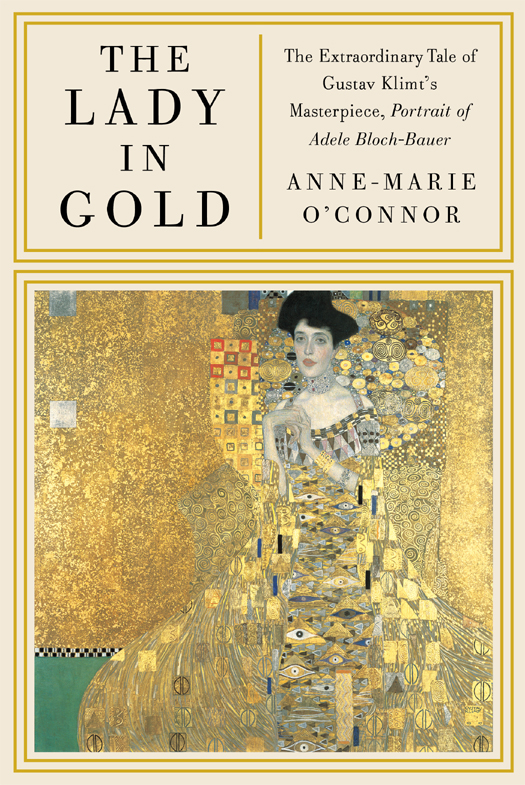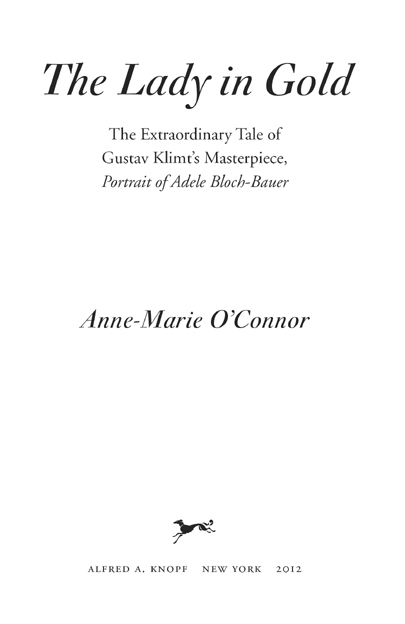THIS IS A BORZOI BOOK
PUBLISHED BY ALFRED A. KNOPF
Copyright 2012 by Anne-Marie OConnor
Portions of this book previously appeared in the Los Angeles
Times Magazine in 2001 and are reprinted with permission.
All rights reserved. Published in the United States by Alfred A. Knopf, a division of Random House, Inc., New York, and in Canada by Random House of Canada Limited, Toronto.
www.aaknopf.com
Knopf, Borzoi Books, and the colophon are registered trademarks
of Random House, Inc.
Library of Congress Cataloging-in-Publication Data
OConnor, Anne Marie.
The lady in gold : the extraordinary tale of Gustav Klimts masterpiece, Portrait of Adele Bloch-Bauer / by Anne-Marie OConnor.1st ed.
p.cm.
Includes bibliographical references and index.
eISBN: 978-0-307-95756-6
1.Klimt, Gustav, 18621918. Adele Bloch-Bauer I. 2.Bloch-Bauer, Adele, 18811925Portraits.I.Title. ND 511.5 K 55 A 618 2012759.36dc232011033578
Front-of-jacket image: Adele Bloch-Bauer I by Gustav Klimt, 1907. Oil, silver, and gold on canvas. This acquisition made available in part through the generosity of the heirs of the Estates of Ferdinand and Adele Bloch-Bauer. Neue Galerie New York, New York, N.Y., U.S.A. Photo: Neue Galerie New York / Art Resource, N.Y.
Back-of-jacket photograph of Adele Bloch-Bauer, 1907. Courtesy Maria Altmann.
Jacket design by Jason Booher
Manufactured in the United States of America
v3.1
To William Booth,
Mary Patricia OConnor,
and
Carolyn Koppel
Contents
Illustrations
The Belvedere Palace. Irina Korshunova, Shutterstock.
Adele Bauer at sixteen. Courtesy Maria Altmann.
Franz Joseph, Emperor of Austria. Photo style of Carl Pietzner-Wien, sterreichische Nationalbibliothek.
Katharina Schratt. Adele, Atelier.
Adele Bauers sister, Therese. Artist unknown; photo of pastel sketch by Anne-Marie OConnor.
Gustav Klimt. Madame dOra, Atelier.
Jeanette Bauer. Courtesy Maria Altmann.
Ferdinand Bloch. Courtesy Maria Altmann.
The empress Elisabeth. By Wilhelm Richter.
Gustav Klimt and fellow artists. Photo by Moritz Nahr.
The future Alma Mahler. Mahler-Werfel Papers, Rare Book and Manuscript Library, University of Pennsylvania.
Mizzi Zimmermann. Gustav Klimt, Schubert at the Piano, 1899.
Mark Twain. Charles Scolik, sterreichische Nationalbibliothek.
Gustav Klimt. Photo by Ankowicz-Kleehoven.
Adele Bauer. Courtesy Maria Altmann.
Klimts Judith, 1901.
Felix Salten. Madame dOra, Atelier.
Danae, by Klimt.
Klimt, 1912. Photo by Moritz Nahr. Courtesy Maria Altmann.
Adele in her early forties. Courtesy Maria Altmann.
Adeles niece Maria Bloch-Bauer. Courtesy Maria Altmann.
Fritz Altmann. Courtesy Maria Altmann.
Maria at a ladies lunch. Courtesy Maria Altmann.
Maria, Ischl, Austria. Courtesy Maria Altmann.
Maria and Luise Bloch-Bauer, ca. 1925. Courtesy Maria Altmann.
Maria Bloch-Bauer and her sister, Luise, 1927. Courtesy Maria Altmann.
Maria with Ferdinand Bloch-Bauer. Courtesy Maria Altmann.
Maria and Christl, her best friend from childhood until she left Austria. Courtesy Maria Altmann.
Maria at her debutante ball. Courtesy Maria Altmann.
Bernhard Altmann. Courtesy Yvonne and Peter Rubstein.
Maria with friends, Ischl, Austria. Courtesy Maria Altmann.
Maria, Austrian Alps, ca. 1936. Courtesy Maria Altmann.
Maria on her wedding day, December 1937. Courtesy Maria Altmann.
Maria on her honeymoon, Paris Mtro, 1938. Courtesy Maria Altmann.
Newlyweds Maria and Fritz Altmann, St. Moritz, early 1938. Courtesy Maria Altmann.
Erich Fhrer. sterreichische Nationalbibliothek.
Elisabeth Bachofen-Echt. ByGustav Klimt, 191416.
Baroness Luise Gutmann, with Nelly and Franz. Courtesy Nelly Auersperg.
Baron Viktor Gutmann. Courtesy Nelly Auersperg.
Reinhard Heydrich, ca. 1940. Bundesarchiv, Germany.
Heydrich ruled as Nazi governor of Czechoslovakia from Ferdinands Czech castle. Courtesy Maria Altmann.
Bruno Schulz. Courtesy Marek W. Podstolski.
Baldur von Schirach. Bundesarchiv, Germany.
Young Nelly. Courtesy Nelly Auersperg.
Schloss Immendorf, 1936. Photo by H. Seering, sterreichische Nationalbibliothek.
Secret Nazi bunker, Belvedere Palace, 1943. Photo by Martin Gerlach, Vienna City Archive.
Luise and Nelly, ca. 1949. Courtesy Nelly Auersperg.
A depot of stolen art, Ellingen, Germany. The National Archives, College Park, Maryland.
Belvedere Palace, ravaged by Allied bombings, December 1944. sterreichische Nationalbibliothek.
Count Hubertus Czernin. Photo by Heribert Corn.
Randol Schoenberg. Photo by Volker Corell.
Arnold Schoenberg. Copyright Arnold Schoenberg Center, Vienna.
Adeles ex libris by Art Nouveau master Koloman Moser. sterreichische Nationalbibliothek.
Prologue
The Belvedere Palace of war hero Prince Eugene seemed the setting of a fairy tale on the winter morning in 2006 when a young Los Angeles attorney, wearing a long black coat and an habitual air of impatience, trudged through its snowy gardens to lay claim to a painting he had spent years fighting for.
The lone man strode briskly along the imperial palaces frozen pond. Ice clung to the monumental sphinxes standing sentinel along his path, their hair swirling around fiercely beautiful faces, breasts naked between tassels dangling from armor. Their eyes cast a bold gaze, of sated conquest.
The lawyer was Randol Schoenberg, the grandson of a venerated Viennese composer who had fled the rise of Hitler. The return of this ominous heir was anything but welcome. The painting Schoenberg sought was a shimmering gold masterpiece, painted a century earlier, by the artistic heretic Gustav Klimt. It was a portrait of a Viennese society beauty, Adele Bloch-Bauer.
Both artist and model were long dead, but people still enjoyed speculating they had been lovers. Their artistic collaboration produced one of the greatest portraits of the modern age. Austrians regarded the painting as their Mona Lisa.
Schoenberg paused to stamp snow from his boots at the doors of the palace, which now housed the Austrian Gallery, the premier national art museum, though it still bore the name bestowed by Prince Eugene, who called it his Belvedere, or beautiful view. From this hill the Turks had laid siege to Vienna in the last great showdown between East and West, and the soaring green Belvedere roof emulated their billowing tents.
In the distance, St. Stephens Cathedral rose toward the heavens, reaching for the love of God. Its majestic blackened spires towered over the site of an ancient moat built by Roman emperors over the remains of a prehistoric Celtic settlement.
Here was the primeval heart of Vienna.
Above Schoenberg, stone gods and goddesses gazed down from the parapet of the palace. Cherubs cast mischievous glances, as capricious as love itself. A group of Japanese tourists stood and shivered, waiting for the museum to open. Schoenberg hurried past them.


